Chesapeake Bay Field Study Program
Contact us at [email protected] or 703.499.4954 to find out how your school or community group can participate!
April 2008 - Students discover nature close to home at Merrimac Farm Wildlife Management Area.
 Marsteller Middle School seventh grade science students joined PWCA naturalists at Merrimac Farm and helped us discover more about the plants and animals at this new Wildlife Management Area in Nokesville. Marsteller Middle School seventh grade science students joined PWCA naturalists at Merrimac Farm and helped us discover more about the plants and animals at this new Wildlife Management Area in Nokesville.
Spring is an exciting time and Merrimac Farm is a great place to watch wildlife. We saw several species of frogs and some of us were lucky enough to observe mating American Toads lay eggs in the pond.
Click here for more information, including photos as well as a list of animals we found during a catch-and-release activities at the pond, site-seeing with binoculars.
Program Overview
 The Chesapeake Bay Field Study Program is one of Prince William Conservation Alliance’s most rewarding activities. More than 16,000 Prince William public school students, teachers and parent chaperones have joined us for a hands-on field study of local ecosystems at Merrimac Farm Wildlife Management Area, adjacent to Cedar Run in the Occoquan Reservoir watershed, and the Occoquan Bay National Wildlife Refuge, located at the confluence of the Occoquan River and Potomac River just east of Route 1. The Chesapeake Bay Field Study Program is one of Prince William Conservation Alliance’s most rewarding activities. More than 16,000 Prince William public school students, teachers and parent chaperones have joined us for a hands-on field study of local ecosystems at Merrimac Farm Wildlife Management Area, adjacent to Cedar Run in the Occoquan Reservoir watershed, and the Occoquan Bay National Wildlife Refuge, located at the confluence of the Occoquan River and Potomac River just east of Route 1.
Hands-on activities extend science instruction beyond the classroom. The Chesapeake Bay Field Study Program provides youth with the real-life examples they need to relate information from classroom maps and textbooks to their own backyard.
One Grade 7 science teacher wrote us saying, “This trip gives my students important information on local ecosystems that I know everyone saw, because we were all there together. I can’t tell you how much this helps me teach ecology concepts.”
Our learn by doing approach addresses the needs of all learners regardless of individual learning styles. Our small group format encourages investigation, providing opportunities for critical thinking and collaboration. Group discussions join local issues to Chesapeake Bay goals, with a focus on understanding the links between land and water.
Merrimac Farm Wildlife Management Area provides the real-life examples we need to relate information from our classroom maps and textbooks to our day to day lives. By the end of the day, everyone has tales to tell and understands more about why the quality of our local watersheds is important for people and wildlife.
This program directly supports Virginia's commitment as a signatory partner of the Chesapeake 2000 Agreement to provide every student with an outdoor field experience in the Chesapeake Bay Watershed.
In addition, our program complements and supports the Virginia Science Standards of Learning for Grades Four, Six and Seven. More than 16,000 students, teachers and parents have benefited from this program since 1998.
Field Study Stations
The program begins around 9:30 a.m., when students clamber out of big yellow school buses at the Refuge, one of Prince William’s remaining “wild” areas.”
Maybe it’s the sudden exposure to wide open spaces, but only a few students can define a watershed when they arrive. As they walk to their starting station, youth learn that they are at the confluence of the Occoquan River and Potomac River, where waters that drain from from everywhere in Prince William begin their journey to the Chesapeake Bay.
All stations use the Refuge as a guide to help youth understand the term watershed describes an area of land that drains downslope to the lowest point, where surface and ground water move through a network of tributaries. In Prince William, all waters flow to the Potomac River and then on to the Chesapeake Bay.
During the Field Study, youth, teachers and parent chaperones have the opportunity to go birding with binoculars, catch aquatic critters with dip nets and use field microscopes to view specimens. Most youth have never had the opportunity to hold a frog or see an osprey through binoculars. Some begin with misgivings, others dive right in. Before the end of the day even cautious beginners are engaged and often turn out to be excellent frog catchers.
The Chesapeake Bay Field Study Program provides youth with the real-life examples they need to relate information from classroom maps and textbooks to their own backyard. By the end of the day, everyone has made some exciting discoveries and understands more about why the quality of our local watersheds is important for people and wildlife. |
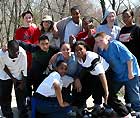
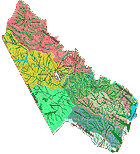
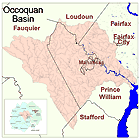
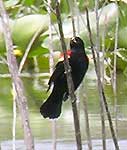 Red-winged blackbirds are perhaps the most abundant bird in North America.
Red-winged blackbirds are perhaps the most abundant bird in North America.
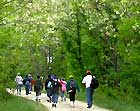
![]()






